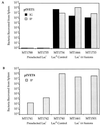Bacterial infection as assessed by in vivo gene expression
- PMID: 9023360
- PMCID: PMC19617
- DOI: 10.1073/pnas.94.3.934
Bacterial infection as assessed by in vivo gene expression
Abstract
In vivo expression technology (IVET) has been used to identify > 100 Salmonella typhimurium genes that are specifically expressed during infection of BALB/c mice and/or murine cultured macrophages. Induction of these genes is shown to be required for survival in the animal under conditions of the IVET selection. One class of in vivo induced (ivi) genes, iviVI-A and iviVI-B, constitute an operon that resides in a region of the Salmonella genome with low G+C content and presumably has been acquired by horizontal transfer. These ivi genes encode predicted proteins that are similar to adhesins and invasins from prokaryotic and eukaryotic pathogens (Escherichia coli [tia], Plasmodium falciparum [PfEMP1]) and have coopted the PhoPQ regulatory circuitry of Salmonella virulence genes. Examination of the in vivo induction profile indicates (i) many ivi genes encode regulatory functions (e.g., phoPQ and pmrAB) that serve to enhance the sensitivity and amplitude of virulence gene expression (e.g., spvB); (ii) the biochemical function of many metabolic genes may not represent their sole contribution to virulence; (iii) the host ecology can be inferred from the biochemical functions of ivi genes; and (iv) nutrient limitation plays a dual signaling role in pathogenesis: to induce metabolic functions that complement host nutritional deficiencies and to induce virulence functions required for immediate survival and spread to subsequent host sites.
Figures


Similar articles
-
Antibiotic-based selection for bacterial genes that are specifically induced during infection of a host.Proc Natl Acad Sci U S A. 1995 Jan 31;92(3):669-73. doi: 10.1073/pnas.92.3.669. Proc Natl Acad Sci U S A. 1995. PMID: 7846034 Free PMC article.
-
Coordinate intracellular expression of Salmonella genes induced during infection.J Bacteriol. 1999 Feb;181(3):799-807. doi: 10.1128/JB.181.3.799-807.1999. J Bacteriol. 1999. PMID: 9922242 Free PMC article.
-
Rcs and PhoPQ regulatory overlap in the control of Salmonella enterica virulence.J Bacteriol. 2007 Sep;189(18):6635-44. doi: 10.1128/JB.00640-07. Epub 2007 Jul 6. J Bacteriol. 2007. PMID: 17616593 Free PMC article.
-
In vivo expression technology for selection of bacterial genes specifically induced in host tissues.Methods Enzymol. 1994;235:481-92. doi: 10.1016/0076-6879(94)35164-3. Methods Enzymol. 1994. PMID: 8057920 Review.
-
Use of mixed infections with Salmonella strains to study virulence genes and their interactions in vivo.Microbes Infect. 2001 Nov-Dec;3(14-15):1345-52. doi: 10.1016/s1286-4579(01)01496-4. Microbes Infect. 2001. PMID: 11755424 Review.
Cited by
-
IFNγ expression by an attenuated strain of Salmonella enterica serovar Typhimurium improves vaccine efficacy in susceptible TLR4-defective C3H/HeJ mice.Med Microbiol Immunol. 2013 Feb;202(1):49-61. doi: 10.1007/s00430-012-0248-z. Epub 2012 Jun 10. Med Microbiol Immunol. 2013. PMID: 22684724
-
Identification and characterization of Yersinia enterocolitica genes induced during systemic infection.Infect Immun. 2000 Dec;68(12):6633-42. doi: 10.1128/IAI.68.12.6633-6642.2000. Infect Immun. 2000. PMID: 11083775 Free PMC article.
-
Identification and testing of Porphyromonas gingivalis virulence genes with a pPGIVET system.Infect Immun. 2002 Feb;70(2):928-37. doi: 10.1128/IAI.70.2.928-937.2002. Infect Immun. 2002. PMID: 11796628 Free PMC article.
-
Plasmid Vectors for in Vivo Selection-Free Use with the Probiotic E. coli Nissle 1917.ACS Synth Biol. 2021 Jan 15;10(1):94-106. doi: 10.1021/acssynbio.0c00466. Epub 2020 Dec 10. ACS Synth Biol. 2021. PMID: 33301298 Free PMC article.
-
Differential gene expression in bacterial symbionts from loliginid squids demonstrates variation between mutualistic and environmental niches.Environ Microbiol Rep. 2010 Aug 1;2(4):514-523. doi: 10.1111/j.1758-2229.2009.00077.x. Environ Microbiol Rep. 2010. PMID: 20680094 Free PMC article.
References
-
- Falkow S. In: Escherichia coli and Salmonella Cellular and Molecular Biology. 2nd Ed. Neidhardt F C, Curtiss R III, Ingraham J L, Lin E C C, Low K B, Magasanik B, Reznikoff W S, Riley M, Schaechter M, Umbarger H E, editors. Washington, DC: Am. Soc. Microbiol.; 1996. pp. 2723–2729.
-
- Mahan M J, Slauch J M, Mekalanos J J. Science. 1993;259:686–688. - PubMed
-
- Davis R W, Botstein D, Roth J R. Advanced Bacterial Genetics. Plainview, New York: Cold Spring Harbor Lab. Press; 1980.
-
- Schmieger H. Mol Gen Genet. 1972;119:75–88. - PubMed
Publication types
MeSH terms
Substances
Grants and funding
LinkOut - more resources
Full Text Sources
Other Literature Sources

